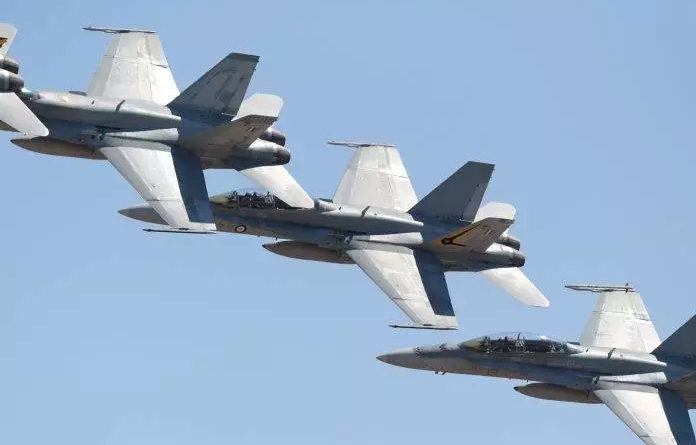Boeing Plans Trials Of Its Super Hornet Jets On Ski-Jump Ramp
February 6, 2020
F/A-18F Super Hornet fighter jets, manufactured by Boeing, flying in formation
Lucknow: US Defence major Boeing is planning trials of its F/A-18 Block III Super Hornet aircraft on ski-jump ramp to prove its ability as the company eyes the multi billion-dollar deal of the Indian Navy for 57 fighter jets.
“Testing plans are underway. We will rigorously check our aircraft on ski jump,” said Thom Breckenridge, Vice-President, International Sales (Strike, Surveillance and Mobility) at Boeing Defence, Space and Security, at the DefExpo 2020, which is being held in Lucknow.
Refusing to get into any specific timeline, Breckenridge said that the aircraft will fulfill the Indian requirements and they are in discussion with the Indian Navy for the trials.
Carrier-based fighters mainly come in three categories — STOVL (short take-off and vertical landing), STOBAR (short take-off but arrested recovery) and CATOBAR (catapult take-off but arrested recovery).
Indian aircraft carriers, both INS Vikramaditya and the under-construction indigenous carrier, use STOBAR technology by using a ski-jump ramp.
The Super Hornets, however, take off from American aircraft carriers using CATOBAR technology.
A ski-jump is the upwardly curved ramp on the deck of aircraft carriers designed to provide sufficient take-off lift for fighter jets.
‘Selection Of American Jets Will Bring US, India Closer’
Breckenridge said the aircraft would be able to land with the arrestor wire used by India and there is no need for any new type.
Interestingly, while pitching for the Super Hornets, the Boeing official also said that selection of the American fighter will bring the US and India closer.
The Indian Navy had issued a Request for Information (RFI) in 2018 for 57 fighter jets “intended as day-and-night capable, all-weather, multi-role, deck-based combat aircraft which can be used for air defence, air-to-surface operations, buddy refuelling, reconnaissance etc. from IN aircraft carriers”.
The Navy currently operates Russian MIG-29K jets from INS Vikramaditya.
The idea is to have another type of fighters for its first indigenous aircraft carrier, which is under construction in Cochin, and also for the second indigenous aircraft carrier, which is still in the planning stage.
Currently, six planes are compatible for aircraft carrier flying — Rafale (Dassault, France), F/A-18 (Boeing, US), MIG-29K (Russia), F-35B, F-35C (Lockheed Martin, US) and Gripen (Saab, Sweden).
One of the foreign fighters, which will finally be chosen, along with the indigenous twin-engine deck-based fighter (TEDBF) aircraft will become the mainstay of the Navy for the next 30-40 years, a Navy officer said.
Boeing In Talks With IAF
Boeing and the Indian Air Force are in talks for performance-based logistics (PBL) support to the fleet of Apache attack helicopters and the Chinook heavy lift.
The PBL support would entail deployment of Boeing employees at the IAF bases from where the helicopters operate to help in servicing and maintenance just like in the case of C-17 aircraft.
This would ensure that there is 80 per cent availability of the fleet round-the-clock.
A similar contract also exists between Boeing and the Indian Navy for maintenance of the P8i maritime reconnaissance and anti-submarine warfare aircraft.
“The contract comes with a two months warranty clause. The talks are currently on between Boeing and the IAF for a longer period,” a Boeing official said.
The first four of the 15 Chinook CH-47F (I) ordered by the IAF in 2015, arrived in India in February last year. The first four of the 22 Apache AH-64E arrived in India in July last year.
Boeing would hand over the last five (each) of the two kinds of choppers this year.
Courtesy: theprint

